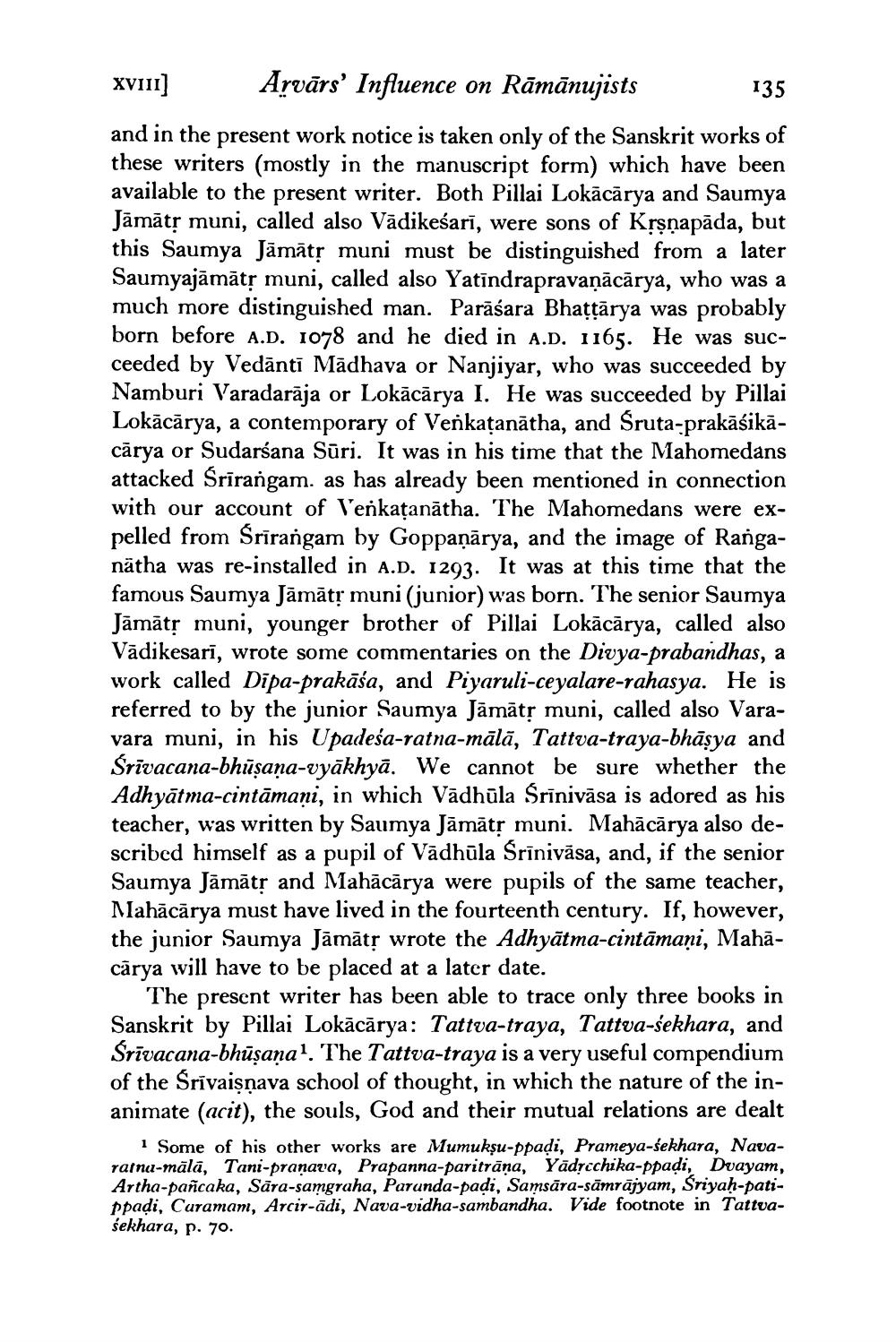________________
XV111] Arvārs' Influence on Rāmānujists 135 and in the present work notice is taken only of the Sanskrit works of these writers (mostly in the manuscript form) which have been available to the present writer. Both Pillai Lokācārya and Saumya Jāmāts muni, called also Vādikeśarī, were sons of Krsnapāda, but this Saumya Jāmātņ muni must be distinguished from a later Saumyajāmātņ muni, called also Yatīndrapravaņācārya, who was a much more distinguished man. Parāśara Bhattārya was probably born before A.D. 1078 and he died in A.D. 1165. He was succeeded by Vedānti Mādhava or Nanjiyar, who was succeeded by Namburi Varadarāja or Lokācārya I. He was succeeded by Pillai Lokācārya, a contemporary of Venkatanātha, and Sruta-prakāśikācārya or Sudarsana Sūri. It was in his time that the Mahomedans attacked Srirangam. as has already been mentioned in connection with our account of Venkațanātha. The Mahomedans were expelled from Srirangam by Goppaņārya, and the image of Ranganātha was re-installed in A.D. 1293. It was at this time that the famous Saumya Jāmātņ muni (junior) was born. The senior Saumya Jāmātņ muni, younger brother of Pillai Lokācārya, called also Vādikesarī, wrote some commentaries on the Divya-prabandhas, a work called Dipa-prakāśa, and Piyaruli-ceyalare-rahasya. He is referred to by the junior Saumya Jāmāts muni, called also Varavara muni, in his Upadeśa-ratna-mālā, Tattva-traya-bhāsya and Śrīvacana-bhūsaņa-vyākhyā. We cannot be sure whether the Adhyātma-cintāmaņi, in which Vādhūla Śrīnivāsa is adored as his teacher, was written by Saumya Jāmāts muni. Mahācārya also described himself as a pupil of Vādhūla Srīnivāsa, and, if the senior Saumya Jāmāt; and Mahācārya were pupils of the same teacher, Mahācārya must have lived in the fourteenth century. If, however, the junior Saumya Jāmāts wrote the Adhyātma-cintāmaņi, Mahācārya will have to be placed at a later date.
The present writer has been able to trace only three books in Sanskrit by Pillai Lokācārya: Tattva-traya, Tattva-sekhara, and Śrīvacana-bhūşanal. The Tattva-traya is a very useful compendium of the Srivaisnava school of thought, in which the nature of the animate (acit), the souls, God and their mutual relations are dealt
1 Some of his other works are Mumuksu-ppadi, Prameya-sekhara, Navarainu-mālā, Tani-pranava, Prapanna-paritrāna, Yādịcchika-ppadi, Dvayam, Artha-pañcaka, Sāra-samgraha, Parunda-padi, Samsāra-sāmrājyam, Sriyah-patippadi, Curamam, Arcir-ādi, Nava-vidha-sambandha. Vide footnote in Tattvasekhara, p. 70.




